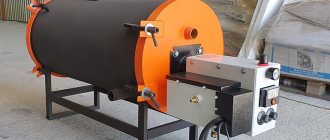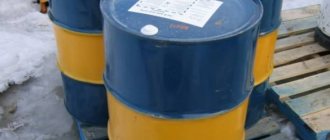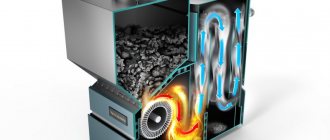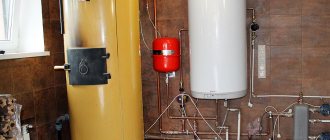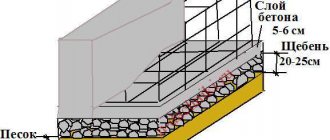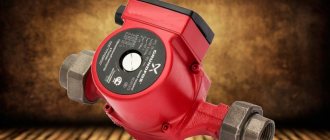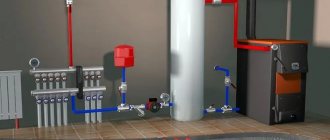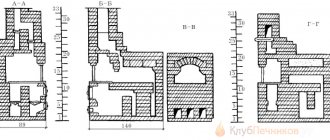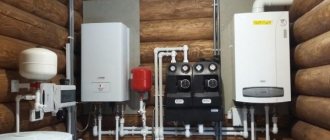By and large, any universal boiler equipped with an oil burner can relate to the topic of the article, but we have previously written that a universal firebox is not always good for working with such burners, and here we talk about specialized oil boilers designed specifically for this type fuel.
| Diesel boiler | Diesel boiler design |
In German exemplary plants, in any modern boiler room you can find a diesel generator, carefully maintained according to regulations and ready to work in the event of a power failure. But this is electricity supply and this is in Europe, which is quite stable in all respects! What can we say about our most unpredictable situations in the cold seasons, once a gas pipe was broken during construction, then the coal supplier closed for an indefinite period, then the road was damaged and it was impossible to deliver firewood... And we are no longer talking only about electricity supply, but about the threat of defrosting an expensive heating system. In situations of complete autonomy, a liquid fuel boiler can be very helpful.
The availability of petroleum products, which include diesel fuel or diesel fuel, heating oil or fuel oil, as well as the absence of the need to coordinate the construction of a boiler house using such fuel with different organizations attracts home owners and organizations and provides a simple solution for heating buildings. Indeed, to install a liquid fuel boiler, you need the boiler itself of a fairly simple design, a burner for liquid fuel and a container for storing its supply.
| A long chimney is practically not required; you can simply insulate its passage in the wall and the flue gases will leave the room without difficulty due to the burner fan. | The boiler is quite heavy, it would be nice to build a foundation for it. The largest element of a liquid fuel boiler house will be a container for storing a supply of diesel fuel, or heating oil, or fuel oil - depending on what will be used for combustion in the boiler. The size and method of installing the tank depends on how the house will be heated and it is worth thinking about this in advance. |
| Chimney | Installation diagram of an underground tank |
Start-up of the boiler plant
3.2.1.
Before lighting the boiler, it is necessary to carry out a pre-start check of the closure of the shut-off valves on the oil pipelines in front of the burners and ignition devices in accordance with the operating instructions. 3.2.2. Before starting up the boiler after an outage of more than 3 days, the serviceability and readiness to turn on the draft mechanisms of the boiler, its auxiliary equipment, measuring instruments and remote control of fittings and mechanisms, auto regulators must be checked, and the operability of protections, interlocks, operational communication equipment must be checked. triggering of the slam-shut valve. When downtime is less than 3 days, equipment, mechanisms, protection devices, interlocks, and measuring instruments on which repairs were carried out are subject to inspection. Identified malfunctions must be eliminated before starting the boiler.
3.2.3. Before starting the boiler, it is necessary to ensure the pressure of fuel oil and steam, air and draft in accordance with the requirements of the operating instructions.
The temperature of the fuel oil before mechanical and steam-mechanical nozzles must correspond to its viscosity of no more than 2.5 °VU, and before steam and rotary nozzles - no more than 6 °VU.
3.2.4. Immediately before igniting the burners, the firebox and gas ducts (including recirculation) must be ventilated for at least 10 minutes with the gas-air duct dampers open and the air flow rate at least 25% of the nominal. The conditions that ensure the required air flow for ventilation must be specified in local regulations. At the same time, the “warm box” must be ventilated.
3.2.5. Ventilation of boilers operating under pressurization, as well as hot water boilers in the absence of smoke exhausters, should be carried out by blower fans and gas recirculation smoke exhausters.
3.2.6. The firing of boilers with balanced draft should be carried out with the smoke exhausters and blower fans turned on, and the kindling of boilers operating under pressurization should be carried out with the blower fans turned on.
3.2.7. The firing of a sulfur fuel oil boiler must be carried out with the air heating system in front of the air heater previously turned on.
3.2.8. According to explosion safety conditions, the firing of a fuel oil boiler can begin with the ignition of any burner or group of burners and be carried out in the sequence specified in the boiler installation operating instructions.
3.2.9. If any of the burners goes out or does not ignite when ignited, the supply of fuel oil to it must be immediately stopped and the ignition device must be turned off. Ignition of the boiler can continue by igniting subsequent burners if at least one burner remains in operation. If there is not a single burner left in operation, then you should be guided by the instructions in paragraph. The switched-off burner must be re-ignited after eliminating the reasons for its extinguishing or non-ignition.
3.2.10. When lighting the boiler, the burners must be ignited using an ignition device; The ignition device must be switched off after stabilization of the burner flame.
(New edition. Change No. 2)
3.2.11. In the event of a torch break in the furnace, the fuel supply to the boiler must be immediately stopped and the pilot lights must be turned off. Only after ventilating the firebox and flues for 10 minutes and eliminating the reasons for the firebox going out can you begin to kindle.
Oil burners for boilers
| Oil burners |
Combined gas-diesel fuel and gas-fuel oil burners are more expensive than specialized liquid fuel burners, but can provide uninterrupted heat supply when changing the type of fuel, for example, when a house is gasified over time. Such burners require adjustment separately for each type of fuel; they have a device, mechanical or electronic, that regulates the air-fuel ratio in the supply mixture, and fuel oil-gas burners provide a fuel oil heater.
Actually, liquid fuel burners are divided into:
— burners with spray nozzles, including steam-mechanical nozzles;
— rotary type burners.
Rotary-type burners are insensitive to the quality of the fuel; in them, it is supplied with a small pressure, from 1 to 3.5 atm, onto a glass rotating at a speed of 5000 rpm. Even the presence of foreign particles in fuel oil does not lead to equipment failure in this type of burner. They are most often used at thermal power facilities.
| Diesel burner |
Burners with atomizing nozzles can be one-, two-, or three-stage, as well as modulating. Step regulation involves operating in one specified power range or switching during operation when the specified coolant temperature is reached to the next range.
The most economical are modulating burners, which smoothly change power from 10 to 100% using mechanical, pneumatic or electronic modulation. Fuel savings with proper configuration of this type of burner can be 5-15%. The cost of such burners is higher than that of step burners, but they will reduce the load on the mechanical parts of the boiler due to frequent switching on/off, increasing its efficiency and operating time in general.
Burner manufacturers often produce unified models suitable for different brands of boilers, and a heating equipment dealership consultant can recommend a suitable one from the available range.
Advantages of liquid fuel boilers
- There are quite obvious advantages of liquid fuel boilers used in industries related to fuels and lubricants. For private homes, the advantages of boilers of this type may raise questions:
- Liquid fuel boilers have a high efficiency of 86 to 98%. This is a good indicator, and it is very close to the indicators of gas boilers;
- An undoubted advantage of diesel boilers, unlike gas boilers, is that you do not need permits (approvals) to install the boiler. Although the combustion room will still have to be equipped;
- Diesel boilers are produced in the most autonomous configurations. Automation of boilers and automatic fuel supply allow minimizing the presence of a person for maintenance;
- Another plus is the ability to quickly and easily, by changing the boiler burner, switch to working with natural gas;
- Although there are no omnivorous boilers, diesel boilers can operate on alternative types of liquid fuel, as indicated in the documentation for the boiler;
- Liquid fuel boilers can fit into any heating system and can work with any coolant (water and antifreeze).
Advantages of an oil boiler house
The obvious advantages (advantages) of a block-modular fuel oil boiler house distinguish it favorably from analogues (for example, solid fuel):
- Factory readiness. High-quality assembly in production conditions.
- Automation. In automated fuel oil boiler houses, equipment is optimally selected and distributed, and all sensors and systems operate without the help of technical personnel.
- Economical. No capital construction costs, no permanent operator presence and low fuel costs.
- Safety. Minimal risk of fire.
It is also worth noting the minimum production time for a fuel oil boiler room - you can always find out more about this from specialists.
Oil farming
The oil farm consists of an open oil warehouse and a hardware room. An oil warehouse usually has above-ground metal tanks mounted on foundations of individual reinforced concrete posts. The open oil warehouse is fenced off from the rest of the territory by an earthen rampart 1.2 m high with a continuous sod. To drain surface water and drain oil in the event of a tank failure, the surface of the warehouse has a slope towards the sewer wells, from which it is planned to release water or oil beyond the TPP site. The oil facility must have four turbine oil tanks and four insulating oil tanks. The capacity of each tank is no less than the capacity of a railway tank - 70 m3, in addition, the permissible minimum capacity depends on the capacity of the oil system of the turbine unit and transformer. For emergency drainage of turbine oil, a special tank is provided at the power plant.
Rice. 9.6. Scheme of a vortex furnace with intersecting jets: 1 - cold radiation surface; 2 - firebox surface covered with refractory coating; 3 - fuel supply
Receiving and draining device
A railway unloading platform for receiving railway tanks with fuel oil is constructed in the form of two longitudinal walls, between which a drain tray is installed. The walls are made of concrete blocks. Depending on the height of the overpass wall and the load-carrying capacity of the tanks, reinforced concrete belts are made along the bottom and top of the walls.
When supplying fuel oil in tanks with a lifting capacity of 50-60 tons, the trestle with a drain tray can be made of a lightweight design without installing a reinforced concrete bottom. A more advanced overpass has also been developed with a drain tray made of reinforced concrete I-beam elements 5.6 m long, weighing 12.5 tons each, representing the walls of the overpass (Fig. 5.16). The lower bars of the walls are connected by loop joints, which are monolid and form the bottom. The walls along the top in the longitudinal direction are connected by loop joints. To avoid freezing of the base, slag filling is carried out under the bottom of the tray. The fuel oil drain tray has a longitudinal slope of 0.01 towards the center of the overpass, from where the fuel oil is drained into an intermediate container. Outlet trays are made of structures similar to those of a railway overpass.
The receiving capacity of the main fuel oil facility must be designed for at least 15% of the capacity of tanks installed for unloading. Typically, the receiving tank consists of two underground tanks with a capacity of 600-1000 m 3 each. To service the tanks, a special overpass is constructed from prefabricated reinforced concrete elements.
Boiler plant
2.3.1. The design of the boiler furnace and the placement of burners in it must ensure the possibility of maintaining a stable combustion process and monitoring this process and exclude the possibility of the formation of stagnant and poorly ventilated zones.
2.3.2. The introduction of recirculating gases into the combustion chamber should not disrupt the stability of the combustion process.
2.3.3. For newly designed boiler plants with a steam capacity of at least 60 t/h, equipped with explosion safety valves, the frames and metal structures of the firebox and gas ducts must be designed for pressure inside the firebox and gas ducts exceeding atmospheric pressure by at least 200 kgf/m2 (2000 Pa). The frames of the firebox and flue ducts of newly designed boilers with a steam capacity of 60 t/h and above, the equipment of which with explosion safety valves is optional, must be designed for internal pressure exceeding atmospheric pressure by at least 300 kgf/m2 (3000 Pa), for installations operating under vacuum, and internal pressure exceeding the maximum operating pressure by at least 300 kgf/m2 (3000 Pa), for units operating under pressurization.
2.3.4. Lookouts must be installed in the boiler firebox to allow observation of combustion and eliminate the possibility of flame emission. The doors of manholes, hatches and peepholes in the furnace and gas ducts of the boiler must be tight and have strong locks that prevent their spontaneous opening.
2.3.5. Gas ducts on the combustion products exhaust line and gas ducts for recirculating combustion products into the boiler furnace must not have unventilated areas in which flammable gas could linger or accumulate.
2.3.6. The boiler air path from the air heater to the burners must be designed in such a way that it can be completely ventilated by blowing into the firebox.
2.3.7. On boilers, the volume where the collectors and boiler hangers are located (“warm box”) must be ventilated.
2.3.8. The areas for servicing fuel oil nozzles, as well as above the exhaust openings of the explosion safety valves of the furnace and gas ducts must be solid.
2.3.9. At boiler plants with a steam capacity of less than 60 t/h, except for boilers made of membrane gas-tight panels and boilers with single-pass gas movement, explosion safety valves are installed in cases provided for by the current “Rules for the design and safe operation of steam and hot water boilers.”
In boiler installations with a steam capacity of 60 t/h and above, explosion safety valves in the furnace and throughout the air and gas ducts up to the chimney may not be installed unless this is provided for in the boiler design.
Gas ducts from the boiler to the chimney must be designed for operating pressure (vacuum).
2.3.10. Boilers must be equipped with means for cleaning convective heating surfaces and air heaters.
2.3.11. Air heaters of boilers must be equipped with fire extinguishing means. Water should be used as the main fire fighting agent. To extinguish a fire in the convection shaft of a boiler with a tubular air heater, it is allowed to use superheated or dry saturated steam instead of water.
2.3.12. The pilot burners of operating boilers must be equipped with ignition protection devices. The remaining burners of operating boilers must be equipped with ignition (IPD) or ignition-protective devices (IPD).
All burners of newly commissioned boilers must be equipped with an emergency protection system.
2.3.13. A looker should be installed on each burner, allowing you to observe the torch of a given burner and the condition of the nozzle.
2.3.14. It must be possible to turn off the fuel supply to the burner manually from the maintenance platform.
2.3.15. The attachment of the nozzle to the block must ensure a tight connection and quick removal and installation of the nozzle. The use of a gasket in the connection between the injector and the block is not recommended.
Normal operation of the boiler system
3.3.1. During boiler operation, it is necessary to monitor:
maintaining the combustion regime in accordance with the regime map, preventing the operation of the furnace with chemical incomplete combustion of fuel and the removal of soot particles from the furnace;
fuel oil pressure after the control valve, not allowing it to decrease below the limit specified in the regime map;
the temperature of the fuel oil in front of the nozzles, not allowing it to decrease below the values determined in accordance with the instructions in paragraph;
a torch, especially when switching from one type of fuel to another, preventing it from going out.
3.3.2. Cleaning the heating surfaces of an operating boiler must be carried out in accordance with the requirements of the operating instructions.
3.3.3. Inspection of fuel oil pipelines in a boiler room must be carried out regularly according to an approved schedule. The inspection periods are established in accordance with the “Rules for the technical operation of electrical stations and networks.”
3.3.4. At least once a shift, an external inspection of operating injectors should be carried out, and if necessary, they should be replaced.
Before installation on the boiler, oil nozzles must be tested on a water stand to check their performance and atomization quality.
At the power plant (boiler house), there must be a person responsible for the stand and testing of fuel oil nozzles on it.
3.3.5. While walking around a working boiler, it is prohibited to open hatches or manholes on the boiler, with the exception of briefly opening inspection hatches and peepholes when standing to the side of them.
Dead-end circuit
It is used when burning relatively low-viscosity fuel oils, when the boiler room operates at stable loads that exceed the average (Fig. 9.3). Fuel for pumps 3
comes from supply tank
5.
When installing a supply tank in the boiler room, it must be closed, with a volume of no more than 5 m3. It is not permitted to install a supply tank above boilers and economizers. The circuit must provide for the circulation of fuel oil from the pressure fuel oil pipeline of the pumps to the supply tank.
When the boilers are operating, the valves on the fuel oil lines behind the boiler burners are closed. When the boilers are stopped, these valves open and the recirculation line to the supply tank comes into operation. Fuel oil in the supply tank comes from the main tanks of the fuel oil storage facility.
Rice. 9.3. Dead-end liquid fuel supply circuit.
1
— fine filter;
2
and
6
—car heaters;
3
- pump;
4
and
9
- coarse filters;
5 — consumable container; 7 and 11 - fuel oil meters; 8 - circulation section; 10
— fuel supply from the main tank.
Fuel consumption is determined by a fuel oil meter 11,
Both rotational meters and special restriction devices can be used as fuel oil meters. Accounting for fuel consumption in a dead-end scheme is simpler than in a circulation scheme: accounting is carried out using one fuel oil meter in front of the boilers.
Reviews of domestic exhaust boilers with a water circuit: advantages and disadvantages
| Advantages | Flaws |
| Availability and symbolic cost of fuel | High initial cost of boilers - almost all models cost more than 100 thousand rubles. |
| Simplicity and reliability - the trouble-free service life of boilers during testing is comparable to gas or diesel analogues, but, of course, depends on the manufacturer | The need for a separate room for the boiler room |
| Environmental friendliness - when the boiler operates correctly, the fuel is completely burned, releasing only harmless nitrogen and carbon dioxide | The need for quality ventilation |
| Simplicity of installation and connection - installation of the boiler does not require a permit; it is not necessary to organize large areas for storing fuel | High operating noise, however, according to reviews from owners, the boiler is not audible even through the relatively thin walls of the boiler room |
| Autonomy - classic models do not require human intervention and can work for months (except for the need for regular cleaning) | The need for regular cleaning (every 24 hours) of more budget vertical models |
| On average, lower (3-7%) efficiency than that of gas or diesel analogues (however, this is a barely noticeable drawback due to the low cost of fuel) | |
| Lack of double-circuit and wall-mounted models | |
| Automation of inexpensive models has rather limited functionality |
Topic 11. Liquid fuel burners
Oil nozzles (mechanical, with a spraying medium, combined steam-mechanical, rotary): design, principle of operation, scope, advantages and disadvantages. Air guide devices.
Oil nozzles.
The nozzle is one of three devices (along with the air guide device and the tuyere - embrasure) that form the burner.
Thermal power plants are supplied with gas from gas distribution stations (GDS) through gas distribution points (GRP) (Fig. 5.1.) The latter, together with the gas pipeline system, make up the gas supply of thermal power plants. At gas-oil condensing power plants with a capacity of up to 1200 MW and gas-oil thermal power plants with a steam flow rate of up to 4000 t/h, there can be one hydraulic fracturing unit, and at other power plants their number must be at least two. The performance of hydraulic fracturing at power plants where gas is the main fuel is calculated based on the maximum gas consumption of all working boilers, and at power plants that burn gas seasonally, based on gas consumption for the summer mode, hydraulic fracturing is located in separate buildings or under sheds on the territory of the power plant. Gas is supplied to each hydraulic fracturing unit via one gas pipeline (without a backup one) from a GDS power station located outside the territory. Gas pressure before the hydraulic fracturing is 0.6-1.1 MPa, and after the hydraulic fracturing its required value is determined by the pressure loss to the boiler furthest from the hydraulic fracturing and the required gas pressure in front of the burners and is usually 0.13–0.2 MPa.
Rice. 5.1.
I—
shut-off valve, 2—flow meter, 3—filter, 4—pressure regulator, 5—safety valve, 6—bypass line, 7—gas flow regulator; 8—pulse shut-off valve, 9—plug valve.
The hydraulic fracturing system has working gas pipeline lines, low-flow lines that are switched on when gas consumption is low, and a reserve line with manual control of the valves. On working lines and low-flow lines, automatic pressure regulators and protective regulators are installed, operating on the “after themselves” principle. Protective regulators are adjusted to higher pressure compared to the operating pressure and are completely open when operating within the design range.
Within the gas distribution zone and up to the boilers, gas pipelines are laid above ground. The gas supply from each gas distribution unit to the boiler room main and from it to the boilers is not reserved and can be carried out as a single line. The gas distribution manifold of the boilers is laid outside the boiler room building.
When filled with gas, gas pipelines must be blown through the discharge candles until all the air is displaced, and when emptying the gas, they must be blown through with air until all the gas is displaced. These requirements are due to the fact that when the volumetric concentration of natural gas in the air is 0.05-0.15 (5-15%), an explosive mixture is formed. From the waste candles, the gas is released to places from where it cannot enter buildings and where the possibility of its ignition is excluded from any source of fire. Only steel fittings are installed on gas pipelines.
Manufacturers of liquid fuel boilers
Power: 0 - 13 kW, heated area: up to 130.0 m2, voltage: 220 V, combustion chamber: closed, number of circuits: double-circuit (heating and hot water), heat exchanger: separate (stainless steel/stainless steel) , overall dimensions (HxWxD): 754x320x520
Power: 0 - 16.8 kW, heated area: up to 130.0 m2, voltage: 220 V, combustion chamber: closed, number of circuits: dual-circuit (heating and hot water), heat exchanger: separate (stainless steel/stainless steel) , overall dimensions (HxWxD): 700x325x602
Power: 0 - 17 kW, heated area: up to 170.0 m2, voltage: 220 V, combustion chamber: closed, number of circuits: double-circuit (heating and hot water), heat exchanger: separate (stainless steel/stainless steel) , overall dimensions (HxWxD): 754x320x520
Power: 0 - 21 kW, heated area: up to 210.0 m2, voltage: 220 V, combustion chamber: closed, number of circuits: double-circuit (heating and hot water), heat exchanger: separate (stainless steel/stainless steel) , overall dimensions (HxWxD): 754x320x520
Power: 15 - 15 kW, heated area: up to 150.0 m2, voltage: 220 V, combustion chamber: closed, number of circuits: double-circuit (heating and hot water), heat exchanger: separate (stainless steel/stainless steel) , overall dimensions (HxWxD): 930x365x650
Power: 13 - 13 kW, heated area: up to 130.0 m2, voltage: 220 V, combustion chamber: closed, number of circuits: double-circuit (heating and hot water), heat exchanger: separate (stainless steel/stainless steel) , overall dimensions (HxWxD): 781x370x683
Power: 17 - 17 kW, heated area: up to 170.0 m2, voltage: 220 V, combustion chamber: closed, number of circuits: double-circuit (heating and hot water), heat exchanger: separate (stainless steel/stainless steel) , overall dimensions (HxWxD): 781x370x683
Power: 0 - 19.8 kW, heated area: up to 190.0 m2, voltage: 220 V, combustion chamber: closed, number of circuits: double-circuit (heating and hot water), heat exchanger: separate (stainless steel/stainless steel) , overall dimensions (HxWxD): 700x325x602
Power: 19.8 - 19.8 kW, heated area: up to 190.0 m2, voltage: 220 V, combustion chamber: closed, number of circuits: dual-circuit (heating and hot water), heat exchanger: separate (stainless steel/stainless steel) , overall dimensions (HxWxD): 920x360x640
Liquid fuel heating equipment is very popular in the domestic market, which is explained by its autonomous operation and modern automation.
The only drawback of these systems is the high cost of fuel and direct installation of equipment. Its installation will be fully justified in areas where there is no connection to the gas main. Sometimes, solid fuel equipment is a good alternative to liquid fuel boilers, but only if there is an energy source in close proximity.
Below we will consider the design and principle of operation of a liquid fuel boiler, as well as its installation.
Types and operating modes of burners for liquid fuels
Some manufacturers sell liquid fuel heating boilers without burners. And that's why. The choice of burners for liquid fuel is quite large and there are many differences in types and operating modes.
Burner types
There are the following types of burners based on fuel:
- Mono fuel burners. They run on only one type of liquid fuel, usually diesel fuel. To switch to oils, you will have to change the burner nozzles.
- Bi fuel burners. They operate on several, often two, types of fuel. There are combinations: diesel-gas, diesel-wood, diesel-wood-coal, etc.
Types of burners by operating mode
We also pay attention to this:
Single-stage burner. Quite primitive, but because of this it is a reliable burner. Adjustment is made by simply turning the burner on/off. They are distinguished by maximum power output and maximum fuel consumption.
Multi-stage burner. This burner is configured to operate according to complex smooth on/off algorithms through intermediate power values. Such burners are expensive, but they save excellent diesel fuel. Typically, such burners are installed on powerful boilers from 40 kW.
How do liquid fuel heating boilers work?
The operating principle of a liquid fuel heating boiler is based on the production of a fuel-air mixture and its subsequent spraying into the combustion chamber. Diesel fuel goes through the following stages of preparation:
- Diesel fuel is poured into a storage facility connected to the fuel pump. To improve thermal efficiency, the walls of fuel tanks placed outdoors or dug into the ground are heated.
The fuel pump takes diesel fuel from storage and supplies it to the burner device, creating pressure in the pipeline. At the same time, the fuel pump sets the operating mode of the heating boiler using liquid fuel. Using sensor readings, the controller determines the quality of diesel fuel and the percentage of its thickening, changing the intensity and flow rate.
Diesel fuel is supplied to the preparation chamber. In the block, the fuel is pre-mixed with air and heated to a temperature optimal for combustion.
The fuel-air mixture is supplied to the boiler nozzle, which is responsible for uniform injection of fuel into the combustion chamber. The nozzle design is based on the use of a mechanical, hydraulic or electronic valve. Fuel is injected into the combustion chamber in the form of highly flammable fine dust. Inside the liquid fuel nozzle, there is an electrode that ignites the air-fuel mixture.
To accumulate the heat generated by burning fuel, a liquid fuel heating boiler uses a heat exchanger made of cast iron, stainless steel or structural steel. For heating hot water, the secondary circuit is made of copper.
Liquid fuel heating boilers are equipped with automation systems and multi-level protection that prevents flame extinction. The most economical heaters are equipped with weather-dependent automation, which independently changes operating settings, depending on the heating temperature of the room and environmental conditions.
What burners are used for liquid fuel
The choice of burner for liquid fuel ultimately determines how economical heating will be. Boilers are equipped with burner devices classified according to several criteria:
- Type of power change - in liquid fuel boilers, modulation and two-stage burners are installed:
- Modulating, they smoothly regulate the heating intensity, changing the power in the range from 30 to 100%, which allows you to adapt to the actual heat needs of the room and avoid excessive fuel consumption.
- Two-stage burners operate in two modes, 30 and 100%. When the coolant heats up to the required temperature, it switches to reduced power.
By type of installation - manufacturers use built-in and wall-mounted devices. Built-in burners, factory installed. After assembly, they are adjusted and debugged. Mounted burner devices are purchased separately and installed independently. How economical the boilers will be depends on the qualifications of the installer - equipment regulator. Burner power is not limited.
The cost of heating directly depends on the type of burner used. For domestic use, the best option is a built-in modulation burner.
What kind of liquid fuel can be used?
The design of modern liquid fuel boilers allows the use of diesel fuel, fuel oil, waste oil, and liquefied gas as a heat source. Before converting boiler equipment to an alternative type of raw material, you should make sure of the following:
- The model provides the ability to burn alternative fuels. Fuel oil, waste oil and diesel fuel have different viscosity, presence of solid particles, and flammability. Accordingly, only a universal boiler can operate on all types of liquid fuel. Manufacturers specifically mention this permissibility in the model description.
There is an opportunity for regular maintenance of the thermal station. When burning waste and fuel oil, a large percentage of soot and soot is released, which settles on the walls of the heat exchanger and chimney pipe. You will have to clean the units every 1-2 days, depending on the quality of the raw materials. It will be necessary to change filters more often and change burner settings.
The heating system with a boiler running on liquid fuel is universal. After certain modifications, boiler equipment is transferred to liquefied gas or exhaust gas, and back to diesel fuel. The best efficiency and thermal efficiency indicators are observed when operating on diesel fuel.
Topic 10. Preparation of liquid fuel for combustion.
Schematic diagram of the fuel oil economy of the boiler room. Preparation of fuel oil for combustion (heating temperature, use of additives).
Schematic diagram of the fuel oil economy of the boiler room.
When operating boiler plants, fuel oil is used as: the main and only type of fuel; reserve and emergency fuel, when the main fuel is gas; kindling fuel, when the main one is solid fuel burned in pulverized form.
Fuel oil is usually delivered by rail in tanks. Fuel oil is supplied to installations located a short distance from oil refineries through pipelines.
Fuel oil facilities for the delivery of fuel oil by rail consist of the following structures and devices: a drain rack and an intermediate tank; fuel oil pumping station with pumps for pumping fuel oil; fuel oil storage facilities with reinforced concrete or metal tanks; fuel oil pipeline systems between fuel oil tanks, fuel oil pumping and boiler plants; devices for heating fuel oil and wastewater treatment; installations for receiving, storing and introducing liquid additives into fuel oil; fire extinguishing systems.
The diagram of the fuel oil facility is shown in Fig. 10.1. From the railway tanks located on the overpass during the draining period, fuel oil flows through a portable drain tray into the drain chute and then through the outlet pipe into the receiving tank. From it, fuel oil is pumped into fuel oil storage tanks (as a rule, at least two tanks are installed). From it, as necessary, through coarse and fine filters and heaters, fuel oil is supplied by pumps to the burners of boiler units. Part of the heated fuel oil is sent through the recirculation line to the fuel oil storage facility to heat the fuel oil located there. To avoid freezing in the pipes, fuel oil continuously circulates in them - after passing along the boiler room, it returns to the fuel oil storage site. Steam lines are laid together with fuel oil lines and provided with general insulation.
Rice. 10.1. Fuel oil preparation scheme: 1 - tank; 2 — channel (tray); 3 — receiving tank; 4 - transfer pump from the receiving tank; 5 - main tank; 6, 10 — coarse and fine filters; 7, 11 — pumps of stages I and II; 8 — fuel oil heater; 9 – fuel oil pumping pump recirculation line; 12 - emergency valves; 13 — fuel oil pressure regulator; 14 - fuel oil consumption; 15 — boiler nozzles; 16 - recirculation fuel oil pipeline from the boiler room to the fuel oil pumping station
Fuel oil filters are designed for coarse and fine cleaning (the number of holes on the mesh is 5 or 40 per 1 cm2) of fuel oil from solid residues of oil fractions and mechanical impurities.
Preparing fuel oil for combustion.
To reduce the amount of bottom sediments during long-term storage, reduce the amount of soot formed during combustion and reduce contamination of the boiler heating surfaces, liquid organic or water-soluble mineral additives (0.5 - 2 kg/t), for example, the VNIINP series, are added to the fuel oil.
Heating of fuel oil is necessary to ensure its fine atomization under conditions of combustion intensification. M40 grade fuel oil should be heated to a temperature of 80 - 100 °C, M100 grade - 100 - 120 °C, M200 grade (the most highly paraffinic) - not lower than 135 °C.
To heat drain trays and heat fuel oil in receiving and main tanks to 70 °C, steam with a pressure of 0.6 - 1.2 MPa or hot water with a temperature of up to 150 °C is usually used.
Which solid fuel is better?
Briquettes
Briquettes
is one of the types of solid fuel made by pressing materials such as shavings, bark, wood dust, straw, wood chips, husks and peat.
There are currently 3 types of briquettes sold on the market:
- RUF
- rectangular briquettes; - NESTRO
- in the form of cylinders with a through hole; - Pini&Kay
- faceted shape (4,6,8 sides).
RUF - rectangular briquettesNESTRO - cylinder-shaped briquettes with a through holePini&Kay - faceted briquettes (4, 6, 8 sides)
They are manufactured using modern European equipment and meet the requirements of technical safety regulations, for which they received their second name - Euro firewood.
Advantages of fuel briquettes:
- are made from environmentally friendly raw materials. When burned, they do not emit harmful substances;
- convenient to store. Thanks to their special shape and heat treatment, they are not exposed to fungi and can be stored outdoors for a long time;
- long and uniform combustion.
- high calorific value. 2 times higher than that of firewood;
- acceptable price;
- ash content level - 1-2%.
Pellets
Pellets
. They are made from the same raw materials as briquettes. However, the production process is slightly different. At the first stage, all materials are crushed to the state of pollen and then dried. After which a special mechanism forms small cylindrical granules from the resulting mass. Thanks to the compact size of the pellets, it has become possible to automate the process of heating a house using solid fuel by supplying a certain amount of pellets from the storage bin to the boiler.
There are several types of pellets:
- from hard and soft wood;
- peat;
- from sunflower husk;
- straw
Wooden pelletsPeat pelletsSunflower husk pelletsStraw pellets
This type of solid fuel is most suitable for use in individual heating systems.
Fuel advantages:
- made from environmentally friendly raw materials;
- can be stored outdoors - they do not swell from moisture and are not protected from the formation of fungus;
- ensure long and uniform combustion;
- due to its small size, it is suitable for automated heating systems;
- wide range of applications - stoves, boilers, fireplaces.
Firewood
Firewood
. This is the most accessible and cheapest type of fuel. And in some areas, firewood can be obtained for free.
The main disadvantage of this option is the need to maintain a certain level of moisture in the logs. Only if this condition is met will the firewood burn well. For high-quality heating, it is necessary to use tree species that burn for a long time. The best options are birch, oak, ash, etc. Coniferous trees are not entirely suitable as solid fuel. When burned, they release a large amount of tar and also have a low specific heat of combustion, so they require frequent loading.
Firewood has few advantages, but they still exist:
- during the combustion process, a minimum amount of caustic substances is released, which means no harm to the environment;
- due to the low level of sulfur content, the corrosive effect is significantly reduced;
- after burning, a small amount of ash is formed - approximately 2-3% of the mass.
Coal
Coal
. This solid fuel is also available in several types: anthracite, stone and brown. Coal is most often used for heating systems.
Main advantages:
- high calorific value;
- ease of storage;
- in many cities, prices for other types of solid fuel are significantly higher than for coal;
- Compared to other fuels, the boiler needs to be filled 2-3 times less often.
But coal also has a considerable number of disadvantages. During combustion, about 40% of the initial mass of ash remains. This means that it will be necessary to allocate a special place for its storage and consider the disposal process. The smoke released during combustion is very corrosive. This is explained by the large amount of sulfur contained in coal. Once in the atmosphere, it is converted into sulfuric acid. Therefore, smog and an unpleasant burning smell may appear indoors and outdoors. However, coal manufacturers and suppliers are trying to combat this disadvantage by creating new boiler models that prevent such substances from entering the air.
The operating principle of the liquid fuel installation and its design
The principle of operation of the boiler is in many ways similar to the operation of a gas floor-standing appliance. The main distinguishing feature is the difference in their designs.
Homemade liquid fuel products have a fan burner for exhaust. Its function is to atomize fuel under high pressure and then feed it into the combustion chamber. The atomization process involves a nozzle that distributes the fuel into small droplets. The raw material itself is transformed into a fog-like form and mixed with the air flow forced by the fan.
The mixture of air and fuel entering the burner leads to the ignition process.
The main characteristic of the effective operation of equipment is its power. In order to understand what power you need a boiler to create a comfortable microclimate, you should carry out a series of thermal calculations.
Factors that are taken into account when calculating the power of the installation:
- area of the heated room;
- number of doors and windows in the room;
- walls and their thickness;
- floor thickness;
- presence of thermal insulation.
In addition, the number of people living also matters in calculating the required power. It is better to entrust such calculations to professionals from the company where you ordered the equipment.
At home, you can only determine the approximate value of the parameter. On average, for a house whose ceiling height does not exceed 3 m, you should purchase a device in accordance with 1 kW of power for every 10 m 2 of area.
Gas burner operating diagram
What are waste oil boilers?
During its operation, the heating device completely burns the processed oil, releasing heat, so that toxic combustion products do not enter the environment, and the room is heated. This approach protects nature and sells recycled oil left over from vehicle operation in large quantities.
The unit is made from a small number of parts, which increases the service life and reliability of the device. The most problematic place is the filter located at the junction of the oil supply to the boiler; it requires replacement as it becomes dirty (every few months).
When the heating device is operating, a lot of carbon dioxide will be released during exhaust; accordingly, this fact should be taken into account during installation.
Scope of use
Heating a room using recycled oil is most often used in car repair shops, small factory workshops, warehouses, i.e. where air heating is not able to heat the entire occupied area to a comfortable temperature.
Also, thanks to a liquid fuel boiler, you can heat a dacha, garage or cottage that does not have access to a central heating network or gas.
Boiler design
The product itself consists of two parts: the evaporation compartment and the combustion chamber. After the oil enters the first container, it is prepared for combustion. Then, moving into the second compartment, the fuel is burned.
Construction of a waste oil boiler.
The oil from the storage tank, thanks to the pump, enters the evaporation section, where a constant high temperature is maintained, suitable for heating and subsequent evaporation. Then the vapors rise to the upper part of the device - the combustion chamber. A fan and an air duct (pipe with holes) are connected to it, through which oxygen enters and, mixing with oil vapors, is completely burned out. The resulting combustion products enter the chimney, and the released heat is distributed by a heat exchanger.
How does it work
Boilers operating on previously used oil are often pyrolysis - the fuel and the volatile substances released from it burn separately. They will consume the gas-air mixture that appears when the contents of the container are heated.
The types of boilers will directly depend on the oil supply system:
- gravity flow, works according to the example of communicating vessels;
- drip type, fuel is supplied to a hot bowl after forced injection by an oil pump.
During operation, no unpleasant odors are felt, but a large amount of carbon dioxide is released. Therefore, it is advisable to install the mount in a non-residential area with good ventilation.
Fuel consumption
Fuel calculations are always made on an individual basis, because... depends on the area of the room, heat loss in it, glazing and operating mode of the heating device.
Fuel consumption depends on the area of the room.
When calculating the required amount of fuel, the efficiency of boilers is approximately 85-90%, which indicates a small loss of heat during operation.
Moving on to numbers: the specific heat of combustion of 1 liter is approximately equal to 11-11.3 kW, i.e., by setting the heater to full power (30 kW), 3 liters of fuel will be consumed. According to observations, 7-8 hours are enough to fully heat a house with an area of 100-150 sq.m; for a private house, garage or cottage, the numbers will be less.
In 2022, the average cost of used oil was approximately 15-20 rubles. per liter, you can purchase it at auto repair shops, DEPOTs, or use the leftovers from your own car.
When purchasing such a boiler, the flow parameters will be specified in the product passport, but if desired, you can recalculate using the formula yourself: B = d*(h1-h2) + d*(h1+h2) /qn, where:
h1 – efficiency,
h2 – fuel enthalpy,
qn – temperature and specific heat capacity of the oil,
d – heat of combustion of fuel.
Fuel storage tank
Now comes the fun part. An oil-fuel boiler requires a container for storing fuel, and I listed this as a disadvantage a little higher.
The calculations shown above indicate that a capacity of several tons is needed. There is no need to invent anything here and it is better to buy a ready-made container with all the built-in equipment: a float, a vapor outlet, a drain valve, a fuel intake kit, a pipeline for discharging fuel to the burner, etc.
Material for containers is steel, polyethylene, fiberglass.
To install the tank, site preparation, excavation, concreting and a lot of special work will be required. You need to understand this and most likely, you will have to hire specialists.
Complete set of fuel oil boiler room
Since these complexes are liquid fuel, the production of an oil boiler depends on various factors:
- Required power.
- Fuel oil stock quantities.
- Options for fuel delivery and storage.
High-quality construction of fuel oil boiler houses is based on accurate calculations and careful selection of appropriate equipment:
- Building.
- Boilers.
- Pump group.
- Expansion membrane tank.
- Fuel supply, unloading and storage system.
- Fuel purification filters.
- Chimney.
- Control system.
- Alarm and other components.
After weighing all the pros and cons, many customers choose fuel oil boiler houses, the price of which varies within reasonable limits. The cost of the system largely depends on the required power and size.
When creating a project for a boiler house using fuel oil, a diagram, drawing, technological map and other calculations are required. Employees are always ready to: correctly calculate the required amount of fuel, the total power of the installation, take into account the availability and need to order the appropriate components, calculate the total amount of investment, etc.
It is best to find out the cost and buy an oil boiler from a specialized company that has:
- Considerable experience in this field.
- All permits.
- Lots of good reviews from established clients.
How much fuel is needed for the season?
One of the most important questions to decide is how much fuel you will need for the season. Let's count.
Simplified, it is considered that:
- 1 liter of diesel fuel allows you to heat an area of up to 100 meters within an hour.
- The boiler consumption is calculated as the power of the burner used multiplied by 0.1.
- And as always, 1 kW of the boiler will heat 10 square meters. meters of house.
Let's make an approximate calculation, from the word example.
A logical question arises: Why, compared to the calculation using the passport (above), did this calculation above give completely different results and where is the correct calculation?
I answer: The error is 72 liters per day. Not one diesel boiler will work 24 hours a day.
As I said, diesel boilers have very serious automation. The boiler will be turned off for 2/3 days, not turned on. Therefore, the calculation should include not 24 hours of work, but 8 hours. That is, the fuel needed for the season is not 10,449 liters, but 3,483 liters.
In addition, modern boilers have technological tricks that also reduce fuel consumption, for example, multi-stage burners, burners with turbo circulation.
One more thing. The calculation given at the beginning of the article is based on the passport data of the boilers, which were compiled taking into account the quality of the fuel in the country of origin. Also, the boiler consumption indicated in the passport is slightly underestimated, since it implies ideal insulation of the house, the outside temperature is minus 10-15˚C and is given for an already heated house (heat maintenance mode).
Therefore, the correct calculation of fuel consumption for the heating season will be somewhere in the middle between 1957.5 liters according to the passport and 3483 liras according to the calculation. We remember that I considered the house to be 300 meters away.
Liquid fuel storage tanks
| Liquid fuel storage tanks |
First of all, let us clarify that according to SNiP, the installation of tanks for storing liquid fuel is prohibited in roof-top boiler rooms and basements.
Currently, tanks are made of steel, aluminum, stainless and enameled steel, and plastic. Made from any material, the container must be durable and airtight, because liquid fuel for the most part is a flammable material and its leakage is dangerous both as a cause for a fire hazard and in terms of environmental pollution.
Tanks differ in above-ground, underground or semi-underground installation and can have a volume from 500 to 20,000 liters. It is possible to connect several tanks to maintain the required supply, but for a separate boiler room the supply should not exceed 150 m³ according to the norm. Tanks made of polypropylene with a volume of up to 5 m³ can be installed directly in the boiler room, separating the tank with a blank wall. In the immediate vicinity of the boiler, only a reserve tank with a volume of no more than 800 liters can be placed at a distance of at least 1 m from the burner.
The shelf life of fuel does not exceed a year and it is more reasonable and profitable to have a supply of it for one heating season. You should calculate the possible consumption for heating the house, select a container of the appropriate size and deliver the fuel at one time, saving on delivery.
Most often today, containers made of polymer materials are used. They are lightweight, not subject to corrosion, can withstand temperatures from -50 degrees C to +50 degrees C, and using fixing packages you can conveniently insert pipelines. The bottleneck of polymer tanks is strength, so in EU countries for containers over 1000 liters. there is a requirement that they be double-walled, but in Russia this is still only a recommendation.
| Diesel fuel storage |
If the container is supposed to be above ground, they often choose it from polymer materials and pay attention to the shape - vertical rectangular tanks that can fit through a doorway are more convenient. Cylindrical tanks are cheaper and they are more often used for large volumes of fuel, over 5 m³; they can be installed in a large room above ground or underground. The distance from the boiler room to the tank must be at least 9 m. Indoor tanks are installed inside a fireproof frame.
Underground fuel storage facilities are safer in a horizontal design; they are equipped with two hatches - for draining fuel and an inspection hatch.
When installing a container outdoors, a fuel pump is required to supply liquid through fuel lines under pressure to the inlet of the burner; in some burner models, the pump is already included in the package.
All fuel tanks have a hole at the bottom to drain the thickening residue; a contaminant filter must be installed at the place where the fuel is drained. For convenience, you can install a fuel level sensor, mechanical or electronic, and, if necessary, a certified fuel heater.
| Photo of a working diesel boiler |
Additional fuel heating is carried out in the burner.
Lighting up the stove
When lighting the stove during testing, it is necessary to inspect the chimney and lower container each time for the presence of water in them. If it is not there, then you can add oil (usually about 2-3 liters). Ignition must be carried out with a lit wick, which is inserted into the container through the hole. The oil usually reaches operating temperature in no longer than 5 minutes, but there are cases when the temperature is reached faster.
To speed up this process, you can add about 100 ml of kerosene to the used oil. The hole in the lower container should be left open literally a couple of centimeters, and later, by pushing the damper in or out, you can regulate the combustion process.
Boiler house building
2.1.1. The category of the boiler room in terms of explosion and fire hazard is determined in accordance with the “List of premises and buildings of energy facilities of the USSR Ministry of Energy indicating the categories of explosion and fire hazard”.
2.1.2. Boiler rooms must have natural or forced ventilation and lighting that meet the requirements of the “Sanitary Standards for the Design of Industrial Enterprises.”
2.1.3. (Deleted. Change No. 2)
2.1.4. The walls inside production premises must be smooth and painted with waterproof paint in light colors.
2.1.5. The floor of the boiler room at the service level and below must have an easily washable coating.
Operating principle of the boiler
The boiler consists of two metal containers connected by a pipe. A chimney is installed in the upper part, the length of which must be at least a meter. The lower container is intended for pouring waste, where the top layer of oil is heated and turns into oil vapor. Rising, the steam exits into a perforated pipe, mixes with air, reaches the upper container and burns. Combustion products exit through the chimney; thus, the boiler heats the room but does not emit toxic waste.
Waste oil heating boilers
A boiler without a water circuit can easily heat a garage of about 40 square meters. m. As for products with a water circuit, they allow you to maintain a comfortable temperature in fairly large rooms even in severe frosts. Moreover, fuel consumption ranges from 0.5 to 1 liter per hour, which makes it possible to significantly save on energy resources.
Pump heating system
Pump heating system. Circulation pump
The exhaust boiler can be made single-circuit or double-circuit, depending on the needs of the owner. If you use coolant only for heating, you need a single-circuit boiler. The second option allows you to heat the room and obtain hot water for domestic purposes; for this purpose, there is a built-in heat exchanger in the upper tank.
Video - Option of a furnace being tested before connecting the water jacket
The operating principle of such a boiler is also quite simple: from the supply tank, the pump delivers the waste to the evaporation chamber, where it is heated and turned into steam. Steam rises into the combustion chamber, mixes with air and heats the water in the circuit. Hot water enters the pipes and radiators, heats the room and returns back to the boiler.
As practice shows, a waste oil boiler is an effective heating device, and also affordable
As practice shows, a waste oil boiler is an effective heating device, and also affordable
As practice shows, a waste oil boiler is an effective heating device, and also affordable
Oil boilers in operation
The operation of a boiler house built using a boiler using fuel oil: the fuel enters the receiving chamber, then, bypassing the storage, it reaches the nozzles through process lines through filters to remove coarse impurities.
Fuel oil heating chambers (preliminary preparation) are installed in front of the nozzle. Next, fuel oil is mixed with condensate to prepare an emulsion.
The finished emulsion is fed through a production line to the burner, where the jet under pressure is ignited using a piezoelectrode.
Conclusions on consumption calculation 1
Based on the given fuel consumption data, you can estimate the cost of heating for the season.
- We take the heating season to be 6 months, or 180 days.
- For a house of 300 meters, a 30 kW boiler is required (1 kW per 10 meters).
- We choose a boiler from the list above at 34.9 kW, which consumes an average of 12 liters of diesel fuel per day. (10.0-14.5 l).
- The maximum fuel consumption for 180 days will be 180×14.5=2610 liters.
- We understand that no one will heat at maximum the whole season. We assume that for 90 days of the heating season the boiler operates at 100%, and for 90 days at 50%.
- We get: 90×14.5+90×14.5/2=1305+652.5=1957.5 liters.
- Diesel fuel 1957.5 liters costs (retail 38 rubles) 74385 rubles (1240 rubles per month).
In the article “Simplified calculation of the heating system,” I showed the calculation based on the power of the heating boiler. Below there will be another calculation that will show different results.
